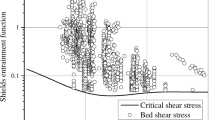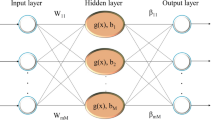Abstract
Sediment transport is one of the major challenging fields in hydrology. The tropical atmosphere, complex topography and occasional extreme precipitation are the fundamental explanations behind this challenge. Thus, the rivers in this situation contain a huge quantity of sediment, which may affect the river hydraulics. Hence, it is required to collect various parameters such as discharge, velocity, rainfall and sediment concentration to analyze the impact of sediment for river engineering practices and management. Therefore, the dataset which is collected from the river may contain outliers and noises. For improving the prediction accuracy of sediment load, we present robust regularized extreme learning machine frameworks to reduce the effect of noise by using the asymmetric Huber loss function named as AHELM and \( \varepsilon {-} \)insensitive Huber loss function named as \( \varepsilon {-} \)AHELM. Further, the problems are rewritten in the form of strongly convex minimization problems whose solutions are acquired by simple function iterative schemes. To ensure the effectiveness of the proposed approach, we have considered the real-world datasets with two types of noises. Furthermore, the proposed schemes are applied on real sediment load datasets (SLDs) which are collected from the Tawang Chu river of Arunachal Pradesh, India. The results reveal that proposed AHELM and \( \varepsilon {-} \)AHELM with multiquadric activation function are performed better for real-world datasets, whereas AHELM and \( \varepsilon {-} \)AHELM with sigmoid activation function perform efficiently and effectively for the sediment load prediction. In overall, the experimental results clearly exhibit the applicability as well as the usability of the proposed extreme learning machine with asymmetric Huber loss functions.








Similar content being viewed by others
References
Asselman NEM (2000) Fitting and interpretation of sediment rating curves. J Hydrol 234(3–4):228–248
Walling DE (1977) Assessing the accuracy of suspended sediment rating curves for a small basin. Water Resour Res 13(3):531–538
McManus JP, Prandle D (1997) Development of a model to reproduce observed suspended sediment distributions in the southern North Sea using principal component analysis and multiple linear regression. Cont Shelf Res 17(7):761–778
Eisazadeh LL, Sokouti R, Homaee M, Pazira E (2013) Modeling sediment yield using artificial neural network and multiple linear regression methods. Int J Biosci 3(9):116–122
Demirci M, Baltaci A (2013) Prediction of suspended sediment in river using fuzzy logic and multilinear regression approaches. Neural Comput Appl 23(1):145–151
Salas JD (1980) Applied modeling of hydrologic time series. Water Resources Publication, Ner York
Nourani V, Roumianfar S, Sharghi E (2013) Using Hybrid ARIMAX-ANN Model for simulating rainfall-runoff-sediment process case study: Aharchai Basin, Iran. Int J Appl Metaheuristic Comput (IJAMC) 4(2):44–60
Alp M, Cigizoglu HK (2007) Suspended sediment load simulation by two artificial neural network methods using hydro meteorological data. Environ Model Softw 22(1):2–13
Melesse AM, Ahmad S, McClain ME, Wang X, Lim YH (2011) Suspended sediment load prediction of river systems: an artificial neural network approach. Agric Water Manag 98(5):855–866
Sharma N, Zakaullah M, Tiwari H, Kumar D (2015) Runoff and sediment yield modeling using ANN and support vector machines: a case study from Nepal watershed. Model Earth Syst Environ 1(3):23
Moeeni H, Bonakdari H (2018) Impact of normalization and input on ARMAX-ANN model performance in suspended sediment load prediction. Water Resour Manage 32(3):845–863
Cimen M (2008) Estimation of daily suspended sediments using support vector machines. Hydrol Sci J 53(3):656–666
Nourani V, Alizadeh F, Roushangar K (2016) Evaluation of a two-stage SVM and spatial statistics methods for modeling monthly river suspended sediment load. Water Resour Manage 30(1):393–407
Shiri J, Kişi Ö (2011) Estimation of daily suspended sediment load by using wavelet conjunction models. J Hydrol Eng 17(9):986–1000
Nourani V, Alami MT, Vousoughi FD (2015) Wavelet-entropy data pre-processing approach for ANN-based groundwater level modeling. J Hydrol 524:255–269
Buyukyildiz M, Kumcu SY (2017) An estimation of the suspended sediment load using adaptive network based fuzzy inference system, support vector machine and artificial neural network Models. Water Resour Manage 31(4):1343–1359
Hamaamin YA, Nejadhashemi AP, Zhang Z, Giri S, Adhikari U, Herman MR (2019) Evaluation of neuro-fuzzy and Bayesian techniques in estimating suspended sediment loads. Sustain Water Resour Manage 5(2):639–654
Huang GB, Zhu QY, Siew CK (2006) Extreme learning machine: theory and applications. Neurocomputing 70(1–3):489–501
Deo RC, Şahin M (2016) An extreme learning machine model for the simulation of monthly mean streamflow water level in eastern Queensland. Environ Monit Assess 188(2):90
Yaseen ZM, Jaafar O, Deo RC, Kisi O, Adamowski J, Quilty J, El-Shafie A (2016) Stream-flow forecasting using extreme learning machines: a case study in a semi-arid region in Iraq. J Hydrol 542:603–614
Lima AR, Cannon AJ, Hsieh WW (2016) Forecasting daily streamflow using online sequential extreme learning machines. J Hydrol 537:431–443
Sun ZL, Choi TM, Au KF, Yu Y (2008) Sales forecasting using extreme learning machine with applications in fashion retailing. Decis Support Syst 46(1):411–419
Chen FL, Ou TY (2011) Sales forecasting system based on Gray extreme learning machine with Taguchi method in retail industry. Expert Syst Appl 38(3):1336–1345
Xu J, Zhou H, Huang GB (2012) Extreme learning machine based fast object recognition. In: 2012 15th international conference on information fusion. IEEE, pp 1490–1496
Liu H, Li F, Xu X, Sun F (2018) Active object recognition using hierarchical local-receptive-field-based extreme learning machine. Memet Comput 10(2):233–241
Zhou Y, Peng J, Chen CP (2015) Extreme learning machine with composite kernels for hyperspectral image classification. IEEE J Sel Top Appl Earth Observ Remote Sens 8(6):2351–2360
Pal M, Maxwell AE, Warner TA (2013) Kernel-based extreme learning machine for remote-sensing image classification. Remote Sens Lett 4(9):853–862
Li X, Xie H, Wang R, Cai Y, Cao J, Wang F, Min H, Deng X (2016) Empirical analysis: stock market prediction via extreme learning machine. Neural Comput Appl 27(1):67–78
Chen L, Qiao Z, Wang M, Wang C, Du R, Stanley HE (2018) Which artificial intelligence algorithm better predicts the chinese stock market? IEEE Access 6:48625–48633
Zhao H, Guo X, Wang M, Li T, Pang C, Georgakopoulos D (2018) Analyze EEG signals with extreme learning machine based on PMIS feature selection. Int J Mach Learn Cybernet 9(2):243–249
Pramanik N, Panda RK, Singh A (2011) Daily river flow forecasting using wavelet ANN hybrid models. J Hydroinform 13(1):49–63
Alizadeh MJ, Kavianpour MR (2015) Development of wavelet-ANN models to predict water quality parameters in Hilo Bay, Pacific Ocean. Mar Pollut Bull 98(1–2):171–178
Li B, Cheng C (2014) Monthly discharge forecasting using wavelet neural networks with extreme learning machine. Sci China Technol Sci 57(12):2441–2452
Shamaei E, Kaedi M (2016) Suspended sediment concentration estimation by stacking the genetic programming and neuro-fuzzy predictions. Appl Soft Comput 45:187–196
Ghose DK (2018) Sediment yield prediction using neural networks at a watershed in south east India. ISH J Hydraul Eng 24(2):230–238
Choubin B, Darabi H, Rahmati O, Sajedi-Hosseini F, Kløve B (2018) River suspended sediment modelling using the CART model: a comparative study of machine learning techniques. Sci Total Environ 615:272–281
Pal SK, Mitra S (1992) Multilayer perceptron, fuzzy sets, and classification. IEEE Trans Neural Networks 3(5):683–697
Yadav A, Chatterjee S, Equeenuddin SM (2018) Suspended sediment yield estimation using genetic algorithm-based artificial intelligence models: case study of Mahanadi River, India. Hydrol Sci J 63(8):1162–1182
Nivesh S, Kumar P (2018) River suspended sediment load prediction using neuro-fuzzy and statistical models: Vamsadhara river basin, India. World 2:1
Toriman E, Jaafar O, Maru R, Arfan A, Ahmar AS (2018) Daily suspended sediment discharge prediction using multiple linear regression and artificial neural network. J Phys Conf Ser 954(1):012030
Emamgholizadeh S, Demneh RK (2019) A comparison of artificial intelligence models for the estimation of daily suspended sediment load: a case study on the Telar and Kasilian rivers in Iran. Water Sci Technol Water Supply 19(1):165–178
Tarar Z, Ahmad S, Ahmad I, Majid Z (2018) Detection of sediment trends using wavelet transforms in the Upper Indus River. Water 10(7):918
Deng W, Zheng Q, Chen L (2009) Regularized extreme learning machine. In: 2009 IEEE symposium on computational intelligence and data mining. IEEE, pp 389–395
Zhang WB, Ji HB (2013) Fuzzy extreme learning machine for classification. Electron Lett 49(7):448–450
Balasundaram S (2013) On extreme learning machine for ε-insensitive regression in the primal by Newton method. Neural Comput Appl 22(3–4):559–567
Balasundaram S, Gupta D (2014) 1-Norm extreme learning machine for regression and multiclass classification using Newton method. Neurocomputing 128:4–14
Khemchandani R, Chandra S (2007) Twin support vector machines for pattern classification. IEEE Trans Pattern Anal Mach Intell 29(5):905–910
Smola AJ, Schölkopf B (2004) A tutorial on support vector regression. Stat Comput 14(3):199–222
Balasundaram S, Gupta D (2016) On optimization based extreme learning machine in primal for regression and classification by functional iterative method. Int J Mach Learn Cybernet 7(5):707–728
Mangasarian OL, Musicant DR (2000) Robust linear and support vector regression. IEEE Trans Pattern Anal Mach Intell 9:950–955
Zhu J, Hoi SC, Lyu MRT (2008) Robust regularized kernel regression. IEEE Trans Syst Man Cybern Part b (cybernetics) 38(6):1639–1644
Balasundaram S, Meena Y (2019) Robust support vector regression in primal with asymmetric Huber loss. Neural Process Lett 49(3):1399–1431
Tanveer M (2015) Newton method for implicit Lagrangian twin support vector machines. Int J Mach Learn Cybernet 6(6):1029–1040
Zhou G, Toh KC (2005) Superlinear convergence of a Newton-type algorithm for monotone equations. J Optim Theory Appl 125(1):205–221
Gupta D (2017) Training primal K-nearest neighbor based weighted twin support vector regression via unconstrained convex minimization. Appl Intell 47(3):962–991
Mehta R, Vishwakarma VP, Rajpal N (2015) Lagrangian support vector regression based image watermarking in wavelet domain. In: 2015 2nd international conference on signal processing and integrated networks (SPIN). IEEE, pp 854–859
Demšar J (2006) Statistical comparisons of classifiers over multiple data sets. J Mach Learn Res 7:1–30
Panda R, Padhee SK, Dutta S (2014) Glof Study in Tawang River Basin, Arunachal Pradesh, India. Int Arch Photogr Remote Sens Spat Inf Sci 40(8):101
Huang X, Shi L, Suykens JAK (2014) Asymmetric least squares support vector machine classifiers. Comput Stat Data Anal 77:371–381
Acknowledgement
This research was supported by ECRA, SERB, DST, New Delhi under early career research Award ECR/2016/001464. We will be forever grateful to NHPC LIMITED, TAWANG BASIN PROJECT for providing the SSL data.
Author information
Authors and Affiliations
Corresponding author
Ethics declarations
Conflict of interest
The authors declare that they have no conflict of interest.
Additional information
Publisher's Note
Springer Nature remains neutral with regard to jurisdictional claims in published maps and institutional affiliations.
Rights and permissions
About this article
Cite this article
Gupta, D., Hazarika, B.B. & Berlin, M. Robust regularized extreme learning machine with asymmetric Huber loss function. Neural Comput & Applic 32, 12971–12998 (2020). https://doi.org/10.1007/s00521-020-04741-w
Received:
Accepted:
Published:
Issue Date:
DOI: https://doi.org/10.1007/s00521-020-04741-w




